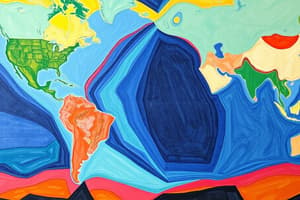Podcast
Questions and Answers
What is the main idea behind the theory of plate tectonics?
What is the main idea behind the theory of plate tectonics?
The Earth's lithosphere is broken into large plates that move relative to each other.
What type of plate boundary is characterized by the movement of plates apart, resulting in the formation of new crust?
What type of plate boundary is characterized by the movement of plates apart, resulting in the formation of new crust?
Divergent
Describe the process of seafloor spreading.
Describe the process of seafloor spreading.
New oceanic crust is created at mid-ocean ridges.
What is the term for the volcanic regions where magma rises to the surface?
What is the term for the volcanic regions where magma rises to the surface?
What is the rock cycle?
What is the rock cycle?
What is the term for the process of sediments being compressed into sedimentary rocks?
What is the term for the process of sediments being compressed into sedimentary rocks?
What is the difference between mechanical and chemical weathering?
What is the difference between mechanical and chemical weathering?
What is the main agent of erosion in coastal areas?
What is the main agent of erosion in coastal areas?
What is the outermost solid layer of the Earth's internal structure?
What is the outermost solid layer of the Earth's internal structure?
What is the source of geothermal energy?
What is the source of geothermal energy?
Study Notes
Plate Tectonics
- Theory: The Earth's lithosphere is broken into large plates that move relative to each other, creating and destroying landforms.
- Types of Plate Boundaries:
- Divergent: Plates move apart, new crust forms (e.g., mid-ocean ridges)
- Convergent: Plates collide, crust is destroyed (e.g., subduction zones)
- Transform: Plates slide past each other horizontally (e.g., fault lines)
- Plate Tectonics Processes:
- Continental drift: continents move across the Earth's surface
- Seafloor spreading: new oceanic crust is created at mid-ocean ridges
- Hotspots: volcanic regions where magma rises to the surface
Rock Cycle
- The Rock Cycle: The continuous process by which rocks are formed, transformed, and destroyed
- Rock Types:
- Igneous: formed from magma or lava
- Sedimentary: formed from compressed sediments
- Metamorphic: formed when existing rocks are altered by heat and pressure
- Rock Cycle Processes:
- Weathering: rocks break down into sediments
- Lithification: sediments are compressed into sedimentary rocks
- Metamorphism: rocks are transformed under heat and pressure
- Magmatic differentiation: magma cools and crystallizes to form igneous rocks
Weathering and Erosion
- Weathering: The breakdown of rocks into sediments through chemical, physical, or biological processes
- Types of Weathering:
- Mechanical weathering: physical breakdown of rocks
- Chemical weathering: chemical reactions that alter rocks
- Factors Affecting Weathering:
- Temperature
- Moisture
- Oxygen
- Types of Weathering:
- Erosion: The transportation of sediments away from their source
- Agents of Erosion:
- Water
- Wind
- Ice
- Types of Erosion:
- Running water
- Glacial erosion
- Coastal erosion
- Agents of Erosion:
Earth's Interior
- Earth's Internal Structure:
- Crust: outermost solid layer
- Mantle: thick, hot, viscous layer
- Outer Core: liquid iron-nickel alloy
- Inner Core: solid, iron-nickel alloy
- Heat and Energy:
- Geothermal energy: heat from the Earth's interior
- Radioactive decay: heat generated by radioactive elements
- Earth's Internal Processes:
- Convection currents: slow circulation of the mantle
- Plate tectonics: movement of the Earth's lithosphere
Plate Tectonics
- The Earth's lithosphere is broken into large plates that move relative to each other, creating and destroying landforms.
- There are three types of plate boundaries: divergent, convergent, and transform.
- Divergent boundaries: plates move apart, new crust forms, e.g., mid-ocean ridges.
- Convergent boundaries: plates collide, crust is destroyed, e.g., subduction zones.
- Transform boundaries: plates slide past each other horizontally, e.g., fault lines.
- Continental drift: continents move across the Earth's surface.
- Seafloor spreading: new oceanic crust is created at mid-ocean ridges.
- Hotspots: volcanic regions where magma rises to the surface.
Rock Cycle
- The rock cycle is the continuous process by which rocks are formed, transformed, and destroyed.
- There are three main types of rocks: igneous, sedimentary, and metamorphic.
- Igneous rocks: formed from magma or lava.
- Sedimentary rocks: formed from compressed sediments.
- Metamorphic rocks: formed when existing rocks are altered by heat and pressure.
- Weathering: rocks break down into sediments.
- Lithification: sediments are compressed into sedimentary rocks.
- Metamorphism: rocks are transformed under heat and pressure.
- Magmatic differentiation: magma cools and crystallizes to form igneous rocks.
Weathering and Erosion
- Weathering: the breakdown of rocks into sediments through chemical, physical, or biological processes.
- Mechanical weathering: physical breakdown of rocks.
- Chemical weathering: chemical reactions that alter rocks.
- Factors affecting weathering: temperature, moisture, oxygen.
- Erosion: the transportation of sediments away from their source.
- Agents of erosion: water, wind, ice.
- Types of erosion: running water, glacial erosion, coastal erosion.
Earth's Interior
- The Earth's internal structure consists of: crust, mantle, outer core, inner core.
- Crust: outermost solid layer.
- Mantle: thick, hot, viscous layer.
- Outer core: liquid iron-nickel alloy.
- Inner core: solid, iron-nickel alloy.
- Geothermal energy: heat from the Earth's interior.
- Radioactive decay: heat generated by radioactive elements.
- Convection currents: slow circulation of the mantle.
- Plate tectonics: movement of the Earth's lithosphere.
Studying That Suits You
Use AI to generate personalized quizzes and flashcards to suit your learning preferences.
Description
Explore the fundamental principles of plate tectonics, including the types of plate boundaries and processes that shape our planet's surface.




